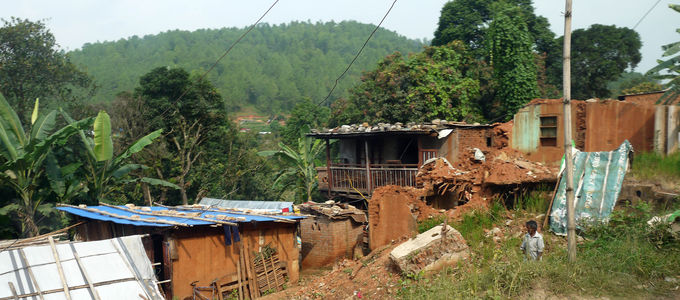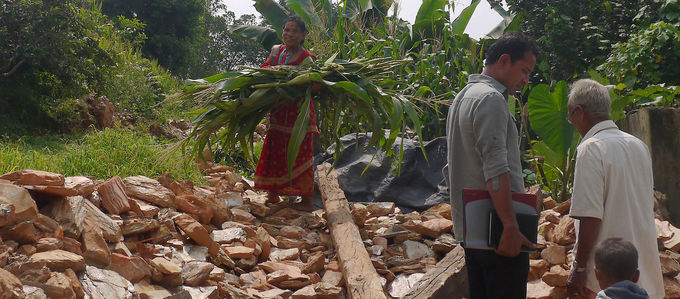
The monsoon season is nearly over. But even then, the people still have to cope with the devastation left by the earthquakes in April and May of this year. On the long path towards normality, Nepal is still at the very beginning. So is the village of Sipapokhare, a village situated in the Himalayan foothills. The following report is from our nac.today correspondent Christy Eckhardt.
The going is slow in this mountainous region some 50 kilometres from the border with China. The roads are in rough shape. Many of the villages we drive through are affected by landslides. The last part of the way we have to walk or, better, climb. The village rests on the hillside. The paths from property to property are steep, and there are no handrails or steps that have been cut into the rock. This is how Christy Eckhardt describes the way to Sipapokhare, a village in which all the homes were affected by the earthquakes. She works for the New Apostolic Church Canada and is responsible, among other things, for aid projects and charitable giving.
The situation remains critical
One can hardly talk about an easing of the situation in the village. Sure, the children are back at school and the men go to work outside the village during the week. But the living conditions are far from back to normal. A devastating earthquake of 7.2 in April and numerous aftershocks destroyed all the homes in the village.
The people live in make-shift shelters, cobbled together from what they found in the rubble and from sheet metal that was supplied as emergency aid. But the people are exposed to extreme weather and unsafe conditions. The shelters are hardly a match for the monsoon rains. The temporary structures are not sealed and they have dirt floors. There is no proper ventilation and there are no proper toilets—and everything is very cramped.
New houses for 25 families
New Apostolic Trust of Nepal, a local aid organisation, wants to help. Currently there are plans to build homes for 25 families in Sipapokhare: single-storey houses with two or three bedrooms. New earthquake resistant designs and building codes issued by the Nepalese government—and passed on to the Village Development Committee—are being considered in the plans.
Construction is scheduled to begin in January 2016, according to New Apostolic Trust of Nepal. The design and material are supplied, while the labour is contributed by the families and volunteers. They will be supervised by a project manager.
Financial support from America and Europe
The initial estimates for the housing project are in the range of 15 million Nepalese rupees, about 144,000 US dollars. The local aid organisation will receive financial support from several institutions of the New Apostolic Church: for one, from the District Church of Canada, which looks after the New Apostolic Christians in Nepal, but also from the Swiss aid organisation NAK Diakonia, as well as NAK-karitativ from Germany.
Meanwhile, aid workers are taking measures to improve the hygienic situation to prevent the spread of disease. Temporary toilets will be constructed outside of the community centre for public use in the next few weeks.
Church used for storage
Also on the list of projects is our church in Sipapokhare. The church in the village is still standing and structurally sound, although in need of repairs.
The church building is currently also being used to store food and supplies, because it was difficult to find a place in the village to store dry food during the monsoon season.
Touching hospitality
Nepal has left a lasting impression on Christy Eckkardt. In retrospect she was startled by the security situation. “One day I wondered why there was so little traffic.” Afterwards she found out that the government had issued a travel advisory because of unrest that day. “The driver had simply relied on his green licence plate.” In Nepal, cars with green licence plates designate tourists.
What touched Christy Eckhardt the most was the people’s warmth and hospitality. She visited an elderly lady who served her something to eat. “She not only shared the little she had, she even went so far as to serve the bananas on a plate.”
























